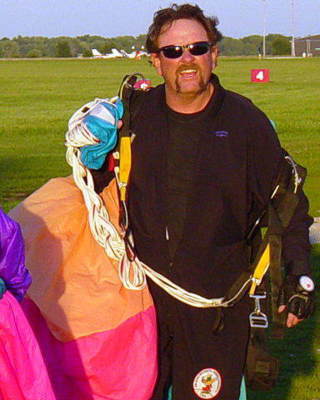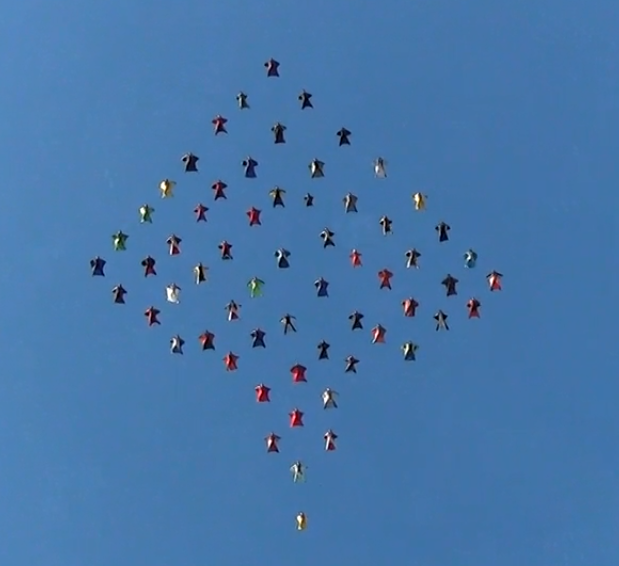Recommended Posts
QuoteI'm bummed. What I thought promised to be an interesting discussion about why license numbers don't seem to match membership numbers is going to become yet another discussion about why people quit jumping.
hey just a thought, but maybe the reason membership and license's dont add up because *gasp* people are quitting the sport.
Lets seeeeee
Lots of A's
Kinda alot of Bs
Some Cs
A few D's
Either A. People stop jumping around A to B qualified , or B. They die between the B and C lisence....
Sudsy Fist: but you're looking damn sudsydoable in this
labrys 0
Quotekiss this ( * )
Dead center wet one
You can't change the graph, dear. You're already in it as one of the "average" jumpers.
labrys 0
Quotehey just a thought, but maybe the reason membership and license's dont add up because *gasp* people are quitting the sport.
And how does that explain overall licenses increasing at a steady rate?
Edit for the beer.
QuoteANd how does that explain overall licenses increases at a steady rate?
Uhhh more exposure. In the old days skydiving was not a sport as much as it is today. I thought the issue was that people arent getting the Cs and Ds. That leads me to believe its cause they are overall just done with the sport or just lack the desire to pay another fee for a different number to be placed on our USPA card.
Sudsy Fist: but you're looking damn sudsydoable in this
bozo 0
QuoteQuotekiss this ( * )
Dead center wet one
You can't change the graph, dear. You're already in it as one of the "average" jumpers.
--------------------------------------------------------
Great....hit me with a word like "average".
You really know how to kick a guy in his ego.
Ok....I'll go away. Get back to your stats
bozo
Pain is fleeting. Glory lasts forever. Chicks dig scars.
Sudsy Fist: but you're looking damn sudsydoable in this
MakeItHappen 15
QuoteI'm bummed. What I thought promised to be an interesting discussion about why license numbers don't seem to match membership numbers is going to become yet another discussion about why people quit jumping.
![[:/] [:/]](/uploads/emoticons/dry.png)
Edit to add: And, it seems, yet another discussion about pie. Take it to the bonfire, eh?
Back on track:
I'm just going to drone on about some issues that have been brought up, but not address people specifically because I'm still trying to understand this.
Yes, it's true that higher license levels can have more licenses than lower license levels. I never got my A or B license.
Years ago, the A license was a mere 10 jumps, then it bumped up to 15, then 20, then 25 then down to 20 then back up to 25 where it is today. When I was a student an A license was nothing to go yell and scream about what I did. It was something your JMs told you to skip paying USPA for and just wait until your D license. Today, instructors encourage you to apply for the license. There are several reasons for this. One is that today's jumpers travel a bit more than they did 20-30 years ago. Two is that you need to have that license card (with or without the official USPA license number) to jump at a new DZ. That situation did not happen that often 20 years ago. Today it does.
The ramp up of mainstreaming AFF and/or Tandem: Both were introduced in 1981. Both had a small and slow entrainment. Tandem saw a burst growth when the drogue was added, but I do not know the exact year for that. Neither of these training methods showed or influenced a trend in licenses from 1981 to 1991.
What strikes me as a significant event in the early 1990's is the introduction of the CYPRES. CYPRES took off slowly too, but within a few years it was bragging about how widespread its use was. In 1996 there was an ad about the Russian 300-way attempts that had something like 80% usage (That's of experienced jumpers, not students) I was one of the ones without a CYPRES then.
If I were to 'explain' the meaning of that graph today, with the data I have on hand, I'd say that people enter the sport assuming that it is almost infallible, but then realize by the time they get their B license or equivalent that the sport can kill you and beg off it, whereas in the early years you knew that from the begining.
.
Make It Happen
Parachute History
DiveMaker
QuoteIf I were to 'explain' the meaning of that graph today, with the data I have on hand, I'd say that people enter the sport assuming that it is almost infallible, but then realize by the time they get their B license or equivalent that the sport can kill you and beg off it,
So they quit? Right? If thats what you think, then why would people think theres a way to change that? Make skydiving safer or make it appear safer? If thats why license numbers are like they are, theres not much that can be done to change it. I think the death factor is very little to do with people getting out at the A/B level but I dont know much as Im just a 100 jump wonder who still jumps like I am in AFF. I think its interesting though to see the stats.
Edit to add. I do not in anyways shape or form think this sport is SAFE, I do believe it can be safer then it is but do not think it is a safe sport.
Sudsy Fist: but you're looking damn sudsydoable in this
bozo 0
-----------------------------------------------------------
I think this last paragraph sums it up, Jan.
The later model "mainstream" student is sold a bill of goods as to how safe jumping is and when they finally do learn the actual facts...thru observation of an accident or a non life threatening event happening to themselves, the reality sets in.
sorry about the hijack
bozo
Pain is fleeting. Glory lasts forever. Chicks dig scars.
pchapman 279
Presumably all the numbers were assigned basically consecutively, without any skipped numbers. (In my country there was once a block of numbers skipped for one licence level because of a clerical error.)
Another 'just to confirm' question: Have the US A license requirements stayed roughly the same since say 1990?
[Edit: Jan / MakeItHappen has covered that in a post while I was writing my answer. Still it would be interesting to know what years the minimum jump numbers changed.]
I would guess that highly organized student programs, especially using AFF related methods, tend to get bunches of students to the A license, even if they don't continue afterwards. If students can rapidly get to the A, some will do it, even if they they decline to go further in the sport. A DZ that isn't as focused on package deals and rapid progression may have students drop out of the program at any time along the way, with less chance of fighting their way through to the A license.
labrys 0
QuoteIf I were to 'explain' the meaning of that graph today, with the data I have on hand, I'd say that people enter the sport assuming that it is almost infallible, but then realize by the time they get their B license or equivalent that the sport can kill you and beg off it, whereas in the early years you knew that from the begining.
I think that's true
QuoteAttached is a diagram of license numbers over the years.
Each data point is the maximum license number published in Parachutist in the January issue of a given year.
Missing data points are either because no licenses were published or I did not have the magazine.
So what do you think about this data and what conclusions would you draw?
I have my theories, but I want to hear your theories.
.
My Theory?
The rate of change is pretty flat and B/C license numbers tend to be consistently higher than A or D numbers.
It suggests to me that most members view the B/C license as the rating to have as it's about the level that is required to jump at most any boogie. Members skip lower ratings and go straight to a B or C license.
Over time, It appears that most USPA members get their A license and then C license.
A license = qualified to jump at any random DZ
C license = "expert" license short of making night jumps.
D license = I will be a tandem instructor, I have made Night jumps, anything else? FAI?
The rise in A licenses could mean anything.
I think, it may suggest more new members are interested in having a USPA rating and enough jumps to be admitted to boogies and less interested in getting an instructor rating or competition at USPA Nationals. C & D's appear to have plataued over the past 2 years
It may mean there is a failure to retain new jumpers or that there is a vast pool of new jumpers that have not yet decided to pursue higher ratings. Why? It is probably some combination of economics and personal motivation.
Maybe I'm wrong.
Ken
Quote
So why does the A license take off in the early 90's and continue to today, but there is no corresponding increase for other licences?
The movie Point Break is what did it for me. Of course I went on to got my B, C and D in the next few years.
MakeItHappen 15
QuoteIt's a great graph that certainly has a lot of years of data on it. To visualize what's been happening more recently, it might be worth focusing only on say 1990 to the present, or even remove having to interpret slopes, by showing only the added quantity per year, not the cumulative. And if one really wants to go nuts, make a per capita version using population statistics...
Presumably all the numbers were assigned basically consecutively, without any skipped numbers. (In my country there was once a block of numbers skipped for one licence level because of a clerical error.)
Another 'just to confirm' question: Have the US A license requirements stayed roughly the same since say 1990?
[Edit: Jan / MakeItHappen has covered that in a post while I was writing my answer. Still it would be interesting to know what years the minimum jump numbers changed.]
I would guess that highly organized student programs, especially using AFF related methods, tend to get bunches of students to the A license, even if they don't continue afterwards. If students can rapidly get to the A, some will do it, even if they they decline to go further in the sport. A DZ that isn't as focused on package deals and rapid progression may have students drop out of the program at any time along the way, with less chance of fighting their way through to the A license.
Normalizing the data would be the next step. But, getting good USPA population numbers is another problem too. I have some of that data and it varies widely form issue to issue, so I'm not so sure that I could give you 'good' normalized data.
The skipped #, in publishing, and clerical errors, I hope have been accounted for. I don't want to burden you with the details. Let's just say I have a double entry, double check on the numbers.
The years that the jump number requirement changes happened: I could go get the specifics, but it would not change the overall picture. The big hop in C&D licenses shows up on the graph, the little hops in the A license do not appear. You can find some of them in the BOD minutes mtgs.
I tend to agree that 'student programs' may 'bunch up' numbers, but I listed the yearly changes, not the month to month changes.
QuoteThe rate of change is pretty flat and B/C license numbers tend to be consistently higher than A or D numbers.
It suggests to me that most members view the B/C license as the rating to have as it's about the level that is required to jump at most any boogie. Members skip lower ratings and go straight to a B or C license.
Over time, It appears that most USPA members get their A license and then C license.
A license = qualified to jump at any random DZ
C license = "expert" license short of making night jumps.
D license = I will be a tandem instructor, I have made Night jumps, anything else? FAI?
The rise in A licenses could mean anything.
I think, it may suggest more new members are interested in having a USPA rating and enough jumps to be admitted to boogies and less interested in getting an instructor rating or competition at USPA Nationals. C & D's appear to have plataued over the past 2 years
It may mean there is a failure to retain new jumpers or that there is a vast pool of new jumpers that have not yet decided to pursue higher ratings. Why? It is probably some combination of economics and personal motivation.
Rate of change, ie the slope of the line is almost constant for all licenses from 1991 to today. There is the blip for the change in C/D # jumps.
The question to answer is why the A license slope is so much steeper than all the other licenses.
.
Make It Happen
Parachute History
DiveMaker
HeatherB 0
And I'm probably one of those people who skews the license numbers. I skipped the A and got the B so I could travel to other dropzones without problems. (I think the A was 20 jumps and B was 50 jumps at that time...with so few jumps b/t licenses, I didn't see the point)
And I haven't gone for a C or D license because there's no compelling reason for me to do so. I have zero desire to go for instructor ratings and I only need a B to compete in intermediate or advanced at Nationals. I'm not going to get a D just to say I have a D.
I think we can work on new jumper retention and have a positive effect and that would help with the license numbers. But you will still have people like me who don't feel the need to go for higher licenses but continue to jump. (and will skew the numbers, regardless of the popularity of the sport at that point in time)
And as someone else said, a good number of jumpers quit around the 100-200 jump mark. Hardly anyone that I started out jumping with still jumps -- the majority of them quit around 200-300 jumps, after getting their C license. Fear and family obligations were typically the reasons.
edit:
Oh, as far as the steep A license slope, my guess would be that it's just the result of skydiving becoming much more mainstream (features in ads, tv shows, movies, etc). More people are exposed to it and get into the sport for the "wow" factor and to check it off their list. They do a tandem or AFF level and the DZ's are cool and everyone treats you like a star. And then the coolness and excitement of it fades away and fear can set in. (resulting in the same ol' C and D license increases)
It might be interesting to track the increase of the number of DZs in the US too. More DZs = more exposure. Of course there's the chicken/egg question with that too.
So we're attracting more jumpers but I doubt we'll ever see a huge percentage of A license jumpers stay. At least that's my guess.
kallend 2,106
Quote
The question to answer is why the A license slope is so much steeper than all the other licenses.
.
Well, USPA has the data on who doesn't renew (and can be presumed to have dropped out) and their license level, and you are a ND, so surely further analysis of these data is within your power. A steep "A" slope yet declining membership is strongly suggestive.
The only sure way to survive a canopy collision is not to have one.
QuoteSo why does the A license take off in the early 90's and continue to today, but there is no corresponding increase for other licences?
"Point Break" and Tandem Skydiving.
QuoteSo why do jumpers go get their A license and boast about it, but yet we do not see them get their B or higher license?
Many of us that continued in the sport at the rapid pace of jumping turbine aircraft and moder dropzones allow, never applied for their B & C licenses. I have an A and a D, thats it.
You're not as good as you think you are. Seriously.









i'm gonna stick around for 20 more years and fuck up the statistics.
bozo
Pain is fleeting. Glory lasts forever. Chicks dig scars.
Share this post
Link to post
Share on other sites